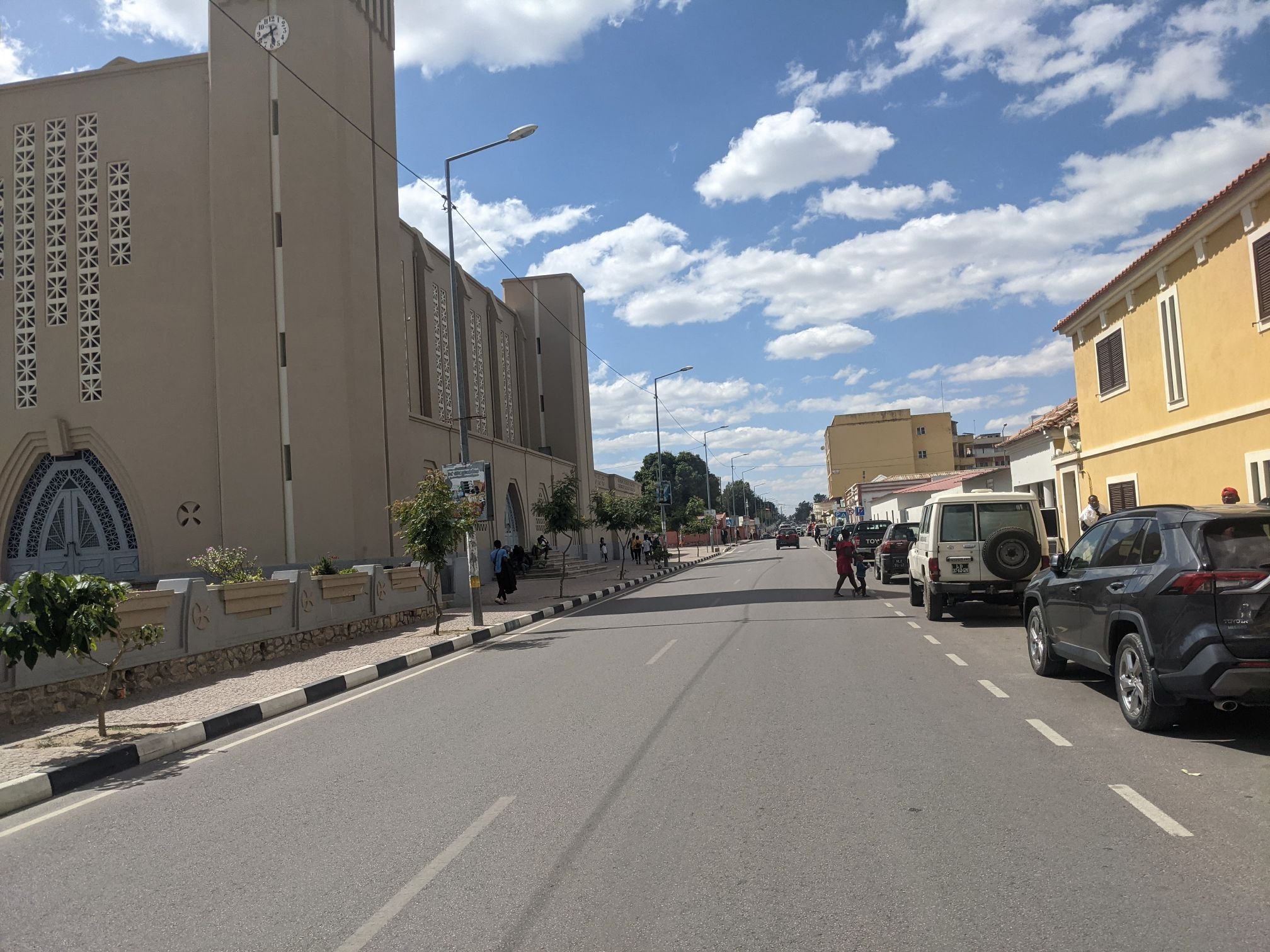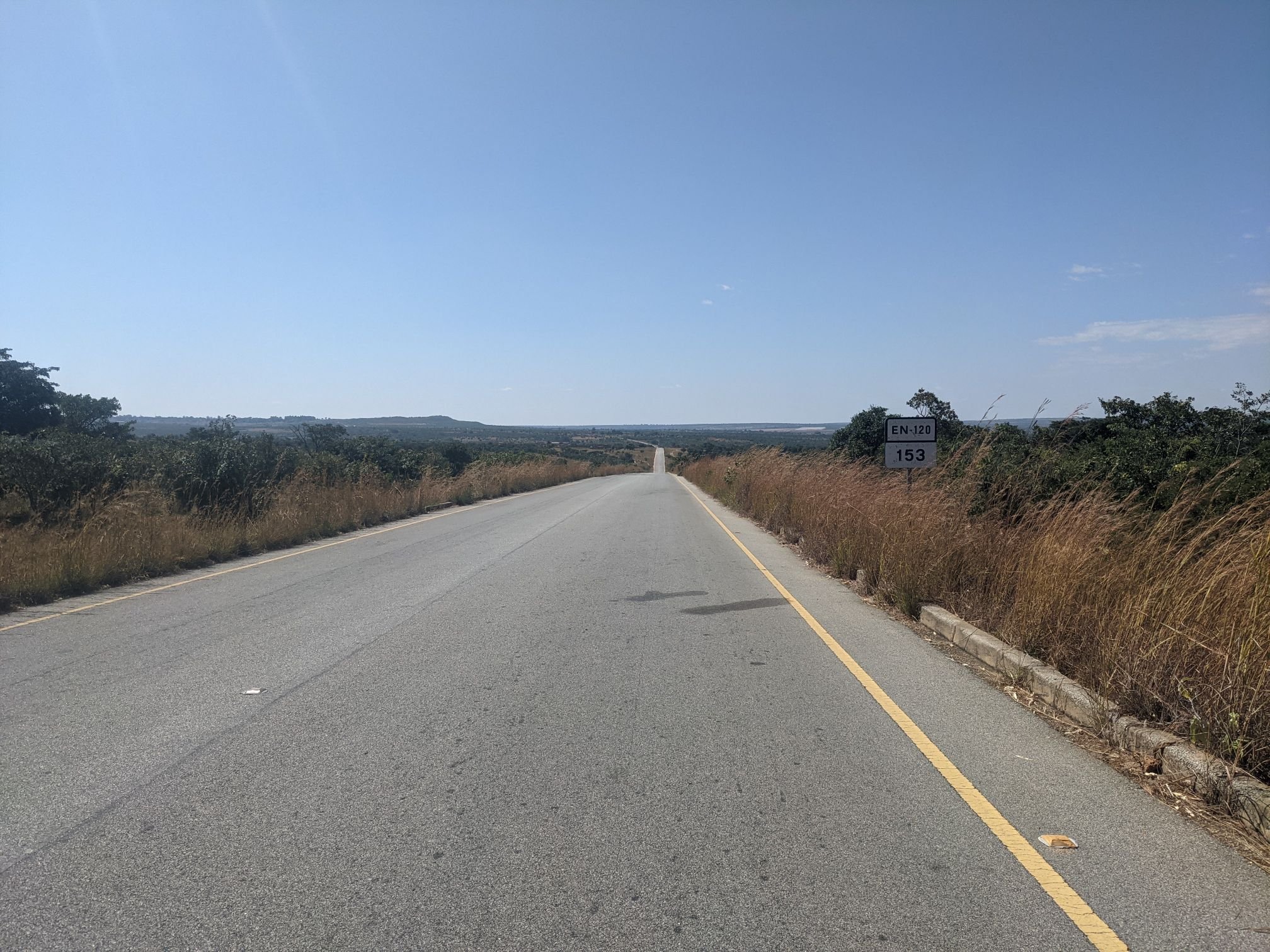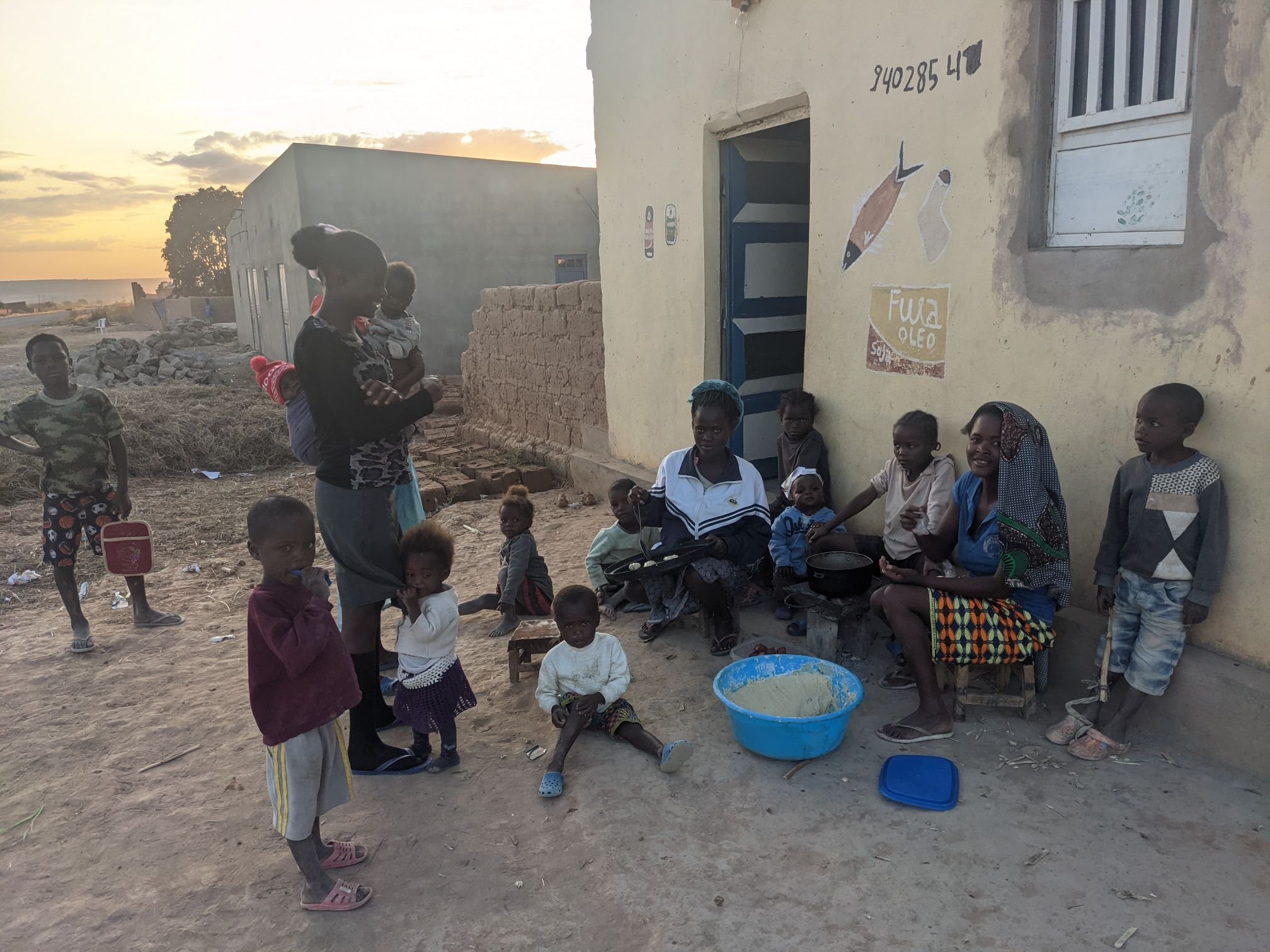After an hour or so of riding I reached the town of Cahama. Though it was the largest town I’d been in for a week or so it was still pretty small, with no shop larger than a minimarket. I didn’t stop there long before riding on, along the quiet main road.
Every half hour or so I passed a village, a collection of buildings, a few of which were of brick, unlike the wooden huts in the countryside. Some had a minimarket, or health center, but not much more.

Around midday I passed through a village where some women were roasting some meat. I bought some and rode on a little before stopping to eat in the shade. I’m not sure what it was – I guess goat – but it was nice, though without a great deal of meat on the bone.
While I was stopped, my rear tyre went flat. I put in a spare tube, which had a 2cm cut in it. I’d patched it but didn’t have a great deal of confidence in it. Indeed it failed shortly after. I patched the previous tube and fitted it… Only for a small hole to suddenly turn into a 5cm tear, marking the end of that tube.
I now had three tubes, two of which had cuts about 2cm long. The patch on these long cuts did not hold well. At one point, when the patch failed, I pushed the bike 10 metres or so from the road, to a patch of shade. In this 10 metres there turned out to have been an incredible number of thorns. I set about removing them from the previously fine tube. Hiss, hiss, hiss… I found 8 holes and that was far from all of them.
It took a long time and a lot of patches but I managed to get them working well enough to cycle a few kilometres further, whereupon I carried the bike away from the road and set up camp.
Having been deflated, patched and reinflated so many times the inner tubes were fatigued pretty close to the point of uselessness. I had to fix them up in the morning and spent the rest of the day making frequent stops to repair one tube or another.

My aim for the day was Lubango, Angola’s second largest city, where I hoped to find some replacement tubes. The day was generally uphill, though with the tubes as they were that was hardly the thing slowing me down. My hand pump had broken, though I thankfully had a spare. I’d bought it because it had a pressure gauge, but it’s incredibly slow at pumping up punctures.
Late in the afternoon the tubes miraculously held together for two hours, and I managed to reach the city. I rode into the center, and was quite concerned by the fact that of the thousands of people I saw, there were only two bicycles. That didn’t bode well for my hope of finding a bike shop.

I spent a while looking for a hotel. Most were remarkably expensive for a poor country. Eventually I managed to negotiate one down to £15. This got me a windowless room with a shared bathroom, with a barely functioning cold shower. I had to go and ask the staff to turn the water on every time I wanted to use the bathroom. I went out to look for a takeaway but prepared food was also remarkably expensive. I’d read that Angola is the most expensive country in which to be an expat, and I can believe it. I settled for a plate of chips at the hotel.
In the morning I set off to search for inner tubes. I asked the hotel receptionist who recommended a shop, quite confidently. I made my way to the shop, which did not have anything bike-related. I got sent around to a few nearby shops, one of which had some bikes – kids bikes. It was a general sport/toy shop. I asked about inner tubes and the guy there recommended I go to Mutondo. I looked it up and that was a town about 13km away.

I decided to try the two malls in the city, and made my way to the nearest. I walked around there but the closest I found to a bike shop was a gym. The woman working there said the hypermarket at the other mall sold bikes.

I made my way there, and it did indeed sell bikes… Three of them, and no parts or accessories. The shop did at least have a wider variety of food at cheaper prices so I bought a load of food and headed back to the hotel. When I got back the staff offered to move me to a nicer room, which was appreciated.
I went out again and searched some more. The best I found were shops selling a few individual bikes – as toys, really. I was recommended the market at Mutondo a couple more times. At the final shop I went to, the Lebanese owner contacted a friend of his who worked at the market. That friend would have a look around and call back to confirm the next morning. In all the hours I’d spent walking around the city I’d not seen a single bicycle, so Mutondo was looking like my best bet.
I bought a pump – a somewhat ludicrously big floor pump. There were smaller ones available but my decision was strongly influenced by the amount of time I’d spent pumping up my tyres lately!
I returned to the hotel and rested for the rest of the day. I fixed up the tyres again and pumped them up – a much quicker process now. In the morning I checked back in with the Lebanese man, whose friend confirmed the market had inner tubes. Around midday I set off.
I made it about 10km before my rear tyre went flat. The patch covering the long cut in the tube was peeling off. I decided to just hitch a ride, then cycle back to ride the remaining 3km. Pretty soon a pickup stopped and I got in the back, just about finding room with the 15 other people there.
We got dropped off and I walked over to the market. Various people were calling out to me, most of whom I ignored. I don’t really know how I picked the one to talk to, but it was a good choice. He told me to wait and dispatched someone to go and get me an inner tube. Within a minute he was back. Result! I bought five. They were quite expensive but I don’t really have much of a choice. They were 26 inch tubes – my bike has 700c wheels, but the tubes will stretch, it’s not a big deal. They have Schrader (car) valves, which is fine for the rear wheel but slightly too large for the hole on my front wheel.

That meant I needed to make the hole bigger. I tried asking the man who’d sorted the inner tubes – a Congolese guy called Ross – but he didn’t know where I’d be able to get that done. For now, I put a new tube in the rear and pumped it up. The front had also gone flat by now, but slowly. I pumped that up so I could ride around searching for a workshop.

Most of the repair work being done was just guys sitting at the side of the road with a bunch of basic tools, no machinery. I spent quite a while wandering around, asking and being led various places. One guy asked for some money to lead me to someone with a drill, which I was fine to pay.
He earned it as far as I’m concerned as it turned out to be quite a walk, and through a maze of houses that I’d never have found my own way through. At last we reached a pair of men working, one with a hacksaw and the other welding some metal doors together. We explained the problem, and they did indeed have a drill. I went off with one of them to buy the right size drill bit.
We returned and set about setting up the drill. It was, surprisingly, Bosch, and looked genuine. However their power source was a car battery. They’d cut the power cable off the drill, and it was wired up to the battery. The drill wouldn’t really tighten properly around the bit, but they got it to work in the end. They drilled the hole, widening the previous one by the couple of millimetres required, seemingly (hopefully) without damaging the rest of the rim. I filed down the edges of the hole, fitted a tube, pumped it up, thanked and paid the men, and headed off.
Since I’d taken a lift the last few kilometres, I set off back to cycle that distance – I’m stubborn about that. Since the tubes had been quite expensive I was a little low on cash. I’d probably be fine but I decided to do the sensible thing and ride an extra few kilometres back and go to an ATM.

By the time all that was done most of the afternoon was gone. I rode for an hour or so. Once I passed Mutondo the land soon returned to countryside, and I made my way into the bush and set up camp.

The next morning I set off, cycling along rolling hills on a road that was now quite potholed. Traffic levels decreased gradually as I moved away from the city of Lubango.

Some villages have police checkpoints, though I’ve not been stopped at any. On one occasion, some policemen caught up to me on a motorcycle a few minutes after passing a checkpoint. They asked if I was going to Luanda, I said yes, and they went back.
Near midday I reached the village of Cacula, where traffic headed for Luanda turned left. I planning on taking a slightly longer route, staying in the mountains rather than going to the coast, in hope of lower traffic and temperatures. Past this junction traffic decreased dramatically, as did the number of potholes.

I’d been looking forward to being able to say I finally had a day without a flat tyre. Unfortunately in the early afternoon I heard that dreaded hissing sound coming from my rear tyre. I listened to find the leak, and saw some glass in the tyre. It was almost comical. Quite recently I’d been thinking about how long it is – years – since I got a puncture due to glass, and how remarkable that is since the roads here are often coated in it. I patched the puncture and got back to cycling.
In the evening I passed a village and stopped to get some food. Some women were frying some dough balls. In East Africa these were called Mendazi; I don’t know what they’re called here. There was a pregnant woman nearby who was very insistent that because I am white I was supposed to give her money. I did not agree. This was quite unusual for Angola – apart from street kids in Lubango, there hasn’t really been any begging.

There was an unusual amount of crop-growing in the area I cycled through in the evening. I ended up having to ride quite late to be able to find somewhere to camp.

There were some dark clouds in the sky so I put the rain cover half-on, just in case. There didn’t turn out to be any rain, but I’d have preferred that. Instead I woke at 1 AM to hear a rustling sound underneath me. It turned out I was on some sort of insect mount. These insects, which looked like ants, had eaten a hole in the floor of my tent. Thankfully unlike ants, they weren’t swarming all over. I picked up the tent and moved a few metres away.
The rolling hills continued the next morning, and a headwind picked up too. I rode along through the uneventful morning.

In the afternoon the tarmac reached an end, and a stretch of unpaved road began. The surface varied, at times bumpy hard packed dirt, other times deep, loose sand.


Late in the afternoon, as the shadows were lengthening, I noticed my rear tyre was slowly losing air. I found the hole in the tube and matched it to a bit of metal wire stuck in the tyre. I got out a spare tube, and found it had a long cut on the inside. It hadn’t gone all the way through but looked like it could tear at any point.
I considered using a different tube, then decided the sensible thing would be to use this one. If the damage is superficial, great. If not, better that I know now rather than carry around a useless inner tube.
It didn’t cause any immediate problem at least, so I continued riding. I reached the village of Catata and stopped to buy some more dough balls. These were smaller but cost just £0.02 each and were served straight off the pan, crispy and warm.

Oddly some of the side streets in Catata had pristine tarmac, but it seemed they’d run out before they got to the main road. Past the town, the road had a layer of tarmac which looked as though it was intended to be a first layer, but construction had been abandoned. The road was blocked off but motorbikes and pedestrians used it regardless, and so did I.

A few kilometres out of the village I made my way away from the road and set up camp. I put the tent on a sheet of rock, making use of the semi-freestanding nature of the tent.
I woke up early, packed up, and was cycling before dawn. The elevation at this point was around 1600m so the mornings are a bit chilly, around 10°C. It warms up quickly once the sun is up, though.

The partially-constructed road soon turned into a fully-constructed road, leading through a forest. It’s been a while since I’ve seen so many tall trees.

Out of the forest the landscape opened up, leaving nothing to block the headwind. I continued along, now somewhat slower.


The road got busier about 20km before the city of Huambo. Inside Huambo itself, there were lots of minibuses and motorbikes swerving all over the place. It was more chaotic than Lubango, but not too bad by African standards.
I wanted to go to a supermarket here. The first one had closed down. There was another, the same as the good one in Lubango, a couple kilometres out of the way. I made my way there and it, too, was closed. All the staff were there though – training, maybe? I also wanted to find contact lens solution, but neither optician I tried had any, and they were sceptical of my finding any in Huambo.
I made my way out of the city after a rather unsuccessful time there. I stopped at a minimarket which, to my surprise, had a local brand of peanut butter. It was about half the price of the imported South African brand I’ve seen elsewhere. It was still expensive but I bought a couple jars – I’ve been struggling to get much protein in Angola.
I continued on for another few hours, then left the road and set up camp. At last, I made it a whole day without a puncture!

May 10: 111 km
May 11: 112 km
May 13: 38 km
May 14: 147 km
May 15: 138 km
May 16: 155 km
Gosh Sam did you dream about punctures !
LikeLike